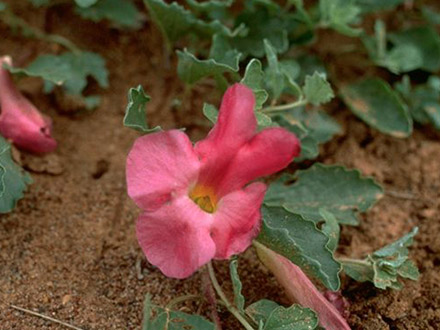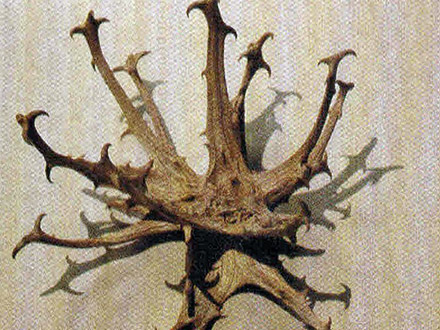Botanical name
Harpagophytum procumbens (Burch.) DC. ex Meisn.
Family
Pedaliaceae
Common name
Grapple plant, Wood spider
Information about the plant
The devil's claw grows in the sandy areas of the savannas of southern Africa (Namibia, South Africa, and Botswana). The genus name Harpagophytum is derived from the Greek "harpagus" (= grappling hook), and the English name "devil's claw" refers to the fruits of the plant. There are egg-shaped seed capsules with several arm-like growths that, after bursting the capsules apart, spread out in a claw-like shape and become very woody. Their sharp barbs can lodge in the hooves of animals and cause infections that can lead to death. The up to 6cm long reddish-purple, gloxinia-style flowers in the axils are highly decorative. The herbaceous plant lies on the ground with long shoots. The leaves are stalked and deeply lobed, usually opposite, but often alternate at the growing ends.
Medicinally used parts of plants (herbal drug)
The bulbous (secondary) storage roots (devil's claw root - Harpagophyti radix), which emerge from the lateral roots, are used. They are dug up, washed, and cut into 0.5 to 1.5cm thick slices while fresh and then dried. This makes them very hard, so they must be crushed while still fresh. The roots can also be obtained from another Harpagophytum species, namely H. zeyheri Decne.
The commercially available drug is imported from southwest Africa and is collected from the wild, although it is increasingly being cultivated.
Constituents of the herbal drug
Devil's claw contains iridoid glycosides, phenolic glycosides, and saccharides.
Quality of the drug
The quality of the following drugs or drug preparations is specified in the European Pharmacopoeia (Ph. Eur.):
- Devil's claw root (Harpagophyti radix)
- Devil's claw root dried extract (Harpagophyti extractum siccum)
Medical applications
Recognised medical use
The HMPC has classified devil's claw root as a traditional herbal medicinal product (see ‘traditional use’).
ESCOP: For the treatment of pain in osteoarthritis and back pain; for loss of appetite and dyspeptic complaints due to its bitter substances.
Traditional use
Devil's claw root has been classified by the HMPC as a traditional herbal medicinal product (Article 16a of Directive 2001/83/EC). Based upon long-standing use, devil's claw root can be used for mild aching limbs and to improve digestive disorders (e.g. bloating, flatulence) as well as for temporary loss of appetite.
Herbal drug preparations in finished dosage forms
- Chopped or coarsely pulverized Devil's claw root for tea preparation
- Dry extracts in coated tablets and capsules
- Alcoholic extracts (also tincture) in drops
- Harpagophytum procumbens homeopathic mother tincture in drops
Dosage
Finished medicinal product: see patient information leaflet.
Tea: Drink a cup of devil's claw root tea 3 times a day. For aching limbs, the daily dose is 4.5 g of the drug; for digestive complaints, 1.5 g of the drug, to be taken in three single doses. The infusion should be consumed 30 minutes before meals to stimulate the appetite and after meals for digestive complaints.
Preparation of a tea
Pour 300 ml of boiling water over 4.5 g or 1.5 g of finely chopped devil's claw root and let it stand for 8 hours at room temperature, then strain and drink in three portions.
Notes
Devil's claw should not be used in case of stomach and duodenal ulcers, and only after consulting a doctor for gallbladder problems.
Do not use devil's claw during pregnancy and lactation without consulting a doctor, as no safety studies have been published. The use in children and adolescents under the age of 18 is not recommended due to a lack of evidence.
Side effects
Rarely, nausea, vomiting, diarrhea, dizziness, and headaches. Very rarely, hypersensitivity reactions such as skin rash, hives, and even anaphylactic shock have been observed.
Interactions
None known.
References
Herbal drug monographs
HMPC (2016), ESCOP (2009), WHO Vol. 3
Further literature
Commentary on the European Pharmacopoeia (Devil's Claw Root, No. 1095; Devil's Claw Root Dry Extract, No. 1871)



